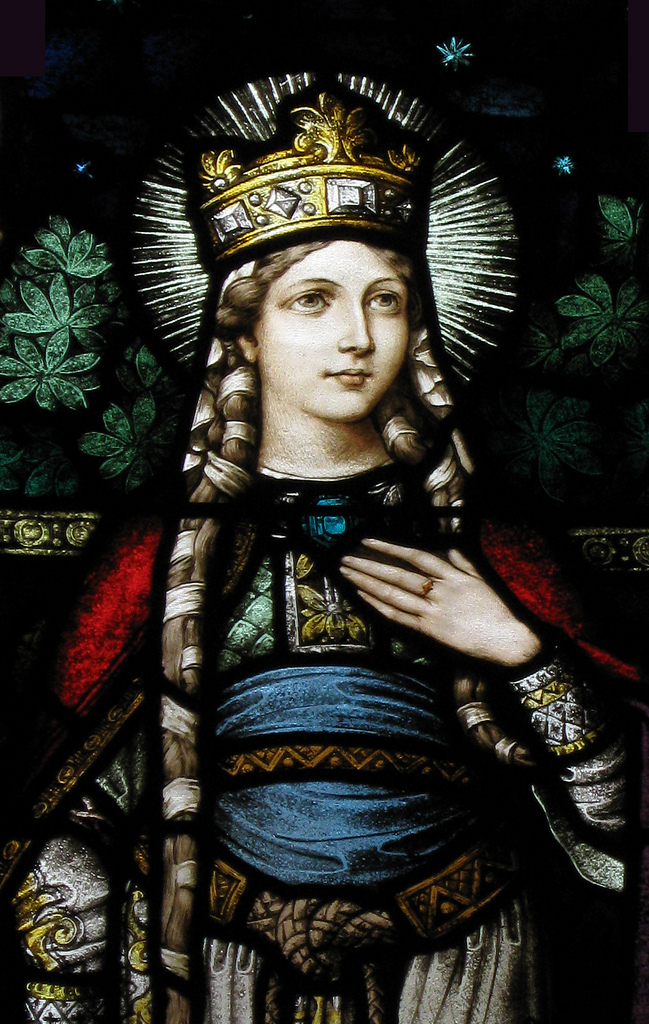
St. Cunegunda was a generous benefactress who practiced stewardship of what she had authority over during her life as a princess, queen, wife, and nun. Cunegunda was born to Siegfried, a count, and his wife Hedwig of Luxembourg, ca. 973, one of eleven children. She was a descendant of Charlemagne. She was betrothed to the young Duke of Bavaria, Henry, and married him in 999. Cunegunda is traditionally believed to have been very beautiful. It is not known for sure if the couple took private vows of celibacy, but the union bore no children.
Princess to Queen to Empress
When Otto III, King of Germany died in 1002, Henry succeeded to the throne. At Rome in 1014, Pope Benedict VIII crowned him Holy Roman Emperor Henry II. Cunegunda was also crowned at her husband’s side. As queen, Cunegunda dedicated herself to living her life as an example of Christian discipleship. Henry himself had been educated by a saint, Wolfgang, the great Benedictine reformer and bishop of Regensburg.

Together, Henry and Cunegunda made it their mission to maintain the kingdom as a Christian one. At some point in time, Henry felt led during prayer to surrender his crown and live as a monk. Cunegunda concurred, agreeing to abdicate her royal position and enter a convent. For confirmation of this decision, Henry sought out the counsel of an abbot, who told him that obedience was a primary duty of a monk. Henry agreed to this obligation. The wise abbot then told Henry, “Carry out the duties that God gave you. He made you Emperor, and you show your obedience to Him by ruling wisely and doing His will in the state of life He called you to.” Thus, the royal couple remained in their positions.
Active in the affairs of the Empire
Cunegunda clearly took an active role in her husband’s vast responsibilities, for she was usually present at his various meetings and councils. She was a positive influence on her husband, and persuaded him to found a monastery and cathedral at Bamberg (currently southern Germany). Pope Benedict personally came to consecrate the monastery and cathedral, which were considered at the time to be among the most beautiful in Europe. Cunegunda, after recovering from a grave illness, founded a Benedictine monastery at Kaufungen, Hesse (currently central Germany).

Innocence proven
Henry and Cunegunda were not spared controversy. The vast expenditures for the building of churches and monasteries meant less resources for luxuries, and some of the ambitious people around the royal couple resorted to gossip and slander, particularly aimed at the queen. Since it is nearly impossible to defend oneself against such accusations, Cunegunda requested and underwent a “trial” by walking barefoot over red-hot irons. This was a practice during medieval times used to test someone’s innocence. To prove the point more completely, she picked up one of the hot irons and carried it through the ordeal in her hands. She completed the trial completely unharmed, putting an end to the gossip. While the building of the monastery at Kaufungen was underway in 1024 but not complete, Henry died.
Empress to nun

Exactly one year after Henry’s death, Cunegunda gathered a great assembly for the dedication of the now-completed abbey church. At the conclusion of the Mass, Queen Cunegunda presented a relic of the true cross. She then removed her royal attire and wore only a coarse brown Benedictine habit which she had sewn herself. From then until her death, she lived as an ordinary nun, although a very diligent one, spending much of her time assisting the poor. She preferred the lowest tasks and never once reminded her fellow nuns of her former position. After fifteen years of life as a nun, Cunegunda died March 3, 1039, at about age sixty six. On her sickbed, when she realized that the nuns were preparing a grand gold garment for her body, she would have none of it, telling them that she wished to be buried in her usual habit. Henry and Cunegunda were buried side by side at Bamberg Cathedral. The original church was destroyed by fire, but the married saints are still buried together in the beautiful rebuilt church. A detailed wooden relief atop the tomb shows what they both looked like. Cunegunda was canonized in 1200 by Pope Innocent III; Henry had been canonized in 1147.
St. Cunegunda left us an excellent example of how to live detached from wealth. She demonstrated that it can be God’s will to live with abundance, but it is necessary to not have one’s heart attached to the things of this world. She freely walked away from the wealth and power that most people seek with great effort. St. Cunegunda is the patroness of her native Luxembourg, and her feast day is March 3.
